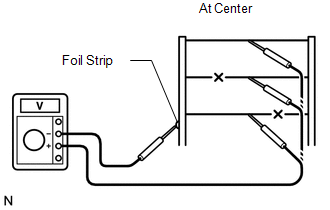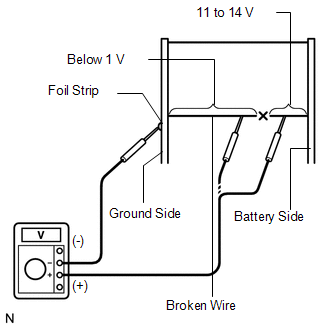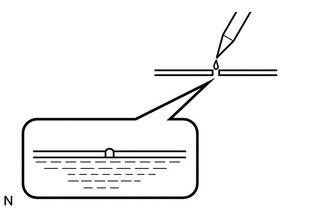Toyota Venza: Window Defogger Wire
On-vehicle Inspection
ON-VEHICLE INSPECTION
PROCEDURE
1. CHECK REAR WINDOW DEFOGGER SYSTEM OPERATION
(a) When the ignition switch is turned to ON and the rear window defogger switch is pressed, check that the rear window defogger system operates.
2. INSPECT BACK DOOR GLASS (REAR WINDOW DEFOGGER WIRE)
NOTICE:
- When cleaning the glass, wipe the glass along the wire using a soft and dry cloth. Take care not to damage the wires.
- Do not use detergents or glass cleaners that have abrasive ingredients.
- When measuring voltage, wrap a piece of tin foil around the tip of the
negative tester probe and press the foil against the wire with your finger,
as shown in the illustration.
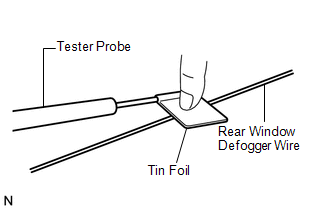
(a) Turn the ignition switch to ON.
(b) Turn the rear window defogger switch on.
|
(c) Measure the voltage at the center of each rear window defogger wire to check the wire, as shown in the illustration. Result:
HINT: If the voltage is 11 to 14 V, the wire may be faulty between the center of the wire and the wire end on the battery side. If the voltage is below 1 V, the wire may be faulty between the center of the wire and the wire end on the ground side. |
|
|
(d) Place a positive (+) lead of the voltmeter against the rear window defogger wire on the battery side. |
|
(e) Place a negative (-) lead of the voltmeter with the foil strip against the wire on the ground side.
(f) Slide the positive (+) lead from the battery side to the ground side. The point where the voltage drops to below 1 V from 11 to 14 V is the place where the rear window defogger wire is broken.
HINT:
If the rear window defogger wire is not broken, the voltmeter should indicate 11 to 14 V at the battery side. When the positive (+) lead slides to the ground side, the voltage gradually decreases to below 1 V.
Repair
REPAIR
PROCEDURE
1. REPAIR REAR WINDOW DEFOGGER WIRE
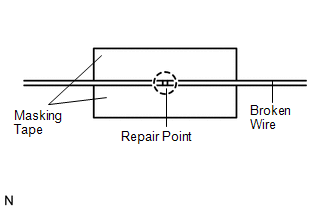
(a) Clean the broken wire tips with a grease, wax and silicone remover.
(b) Place masking tape along both sides of the wire.
|
(c) Thoroughly mix the repair agent (Dupont paste No. 4817 or equivalent). |
|
(d) Using a fine tip brush, apply a small amount of the agent to the wire.
(e) After a few minutes, remove the masking tape.
NOTICE:
Do not repair the rear window defogger wire again for at least 24 hours.
 Rear Window Defogger System does not Operate
Rear Window Defogger System does not Operate
DESCRIPTION
When the rear window defogger switch on the air conditioning control assembly
is pressed, the operation signal is transmitted to the air conditioning amplifier
assembly through the LI ...
Other materials about Toyota Venza:
Inspection
INSPECTION
PROCEDURE
1. INSPECT GENERATOR PULLEY WITH CLUTCH
(a) Hold the center of the pulley, and confirm that the outer ring turns
counterclockwise and does not turn clockwise.
Text in Illustration
*1
...
Removal
REMOVAL
PROCEDURE
1. REMOVE BRAKE BOOSTER ASSEMBLY
HINT:
Refer to the instructions for Removal of the brake booster assembly (See page
).
2. REMOVE HEADLIGHT LEVELING ECU ASSEMBLY (w/ HID Headlight System)
3. REMOVE STOP LIGHT SWITCH ASSEMBLY
4. ...
Disassembly
DISASSEMBLY
CAUTION / NOTICE / HINT
HINT:
Use the same procedure for the RH side and the LH side.
The procedure listed below is for the LH side.
PROCEDURE
1. REMOVE REAR WHEEL
2. REMOVE REAR AXLE SHAFT NUT (for AWD)
NOTICE:
Perform th ...
0.1583

